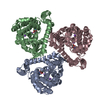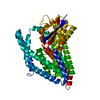[English] 日本語
 Yorodumi
Yorodumi- PDB-8cuj: Human excitatory amino acid transporter 3 (EAAT3) protomer in an ... -
+ Open data
Open data
- Basic information
Basic information
| Entry | Database: PDB / ID: 8cuj | ||||||
|---|---|---|---|---|---|---|---|
| Title | Human excitatory amino acid transporter 3 (EAAT3) protomer in an outward facing apo state in 150 mM NMDG-Cl | ||||||
 Components Components | Excitatory amino acid transporter 3 | ||||||
 Keywords Keywords | TRANSPORT PROTEIN | ||||||
| Function / homology |  Function and homology information Function and homology informationD-aspartate transmembrane transport / regulation of protein targeting to membrane / D-aspartate transmembrane transporter activity / Defective SLC1A1 is implicated in schizophrenia 18 (SCZD18) and dicarboxylic aminoaciduria (DCBXA) / distal dendrite / cysteine transport / cysteine transmembrane transporter activity / neurotransmitter receptor transport to plasma membrane / high-affinity L-glutamate transmembrane transporter activity / glutamate:sodium symporter activity ...D-aspartate transmembrane transport / regulation of protein targeting to membrane / D-aspartate transmembrane transporter activity / Defective SLC1A1 is implicated in schizophrenia 18 (SCZD18) and dicarboxylic aminoaciduria (DCBXA) / distal dendrite / cysteine transport / cysteine transmembrane transporter activity / neurotransmitter receptor transport to plasma membrane / high-affinity L-glutamate transmembrane transporter activity / glutamate:sodium symporter activity / L-glutamate import / response to decreased oxygen levels / cellular response to mercury ion / : / L-glutamate transmembrane transporter activity / retina layer formation / L-glutamate transmembrane transport / glutathione biosynthetic process / D-aspartate import across plasma membrane / L-aspartate transmembrane transport / cellular response to ammonium ion / righting reflex / zinc ion transmembrane transport / L-aspartate transmembrane transporter activity / cellular response to bisphenol A / intracellular glutamate homeostasis / grooming behavior / L-aspartate import across plasma membrane / Glutamate Neurotransmitter Release Cycle / monoatomic anion channel activity / L-glutamate import across plasma membrane / proximal dendrite / transepithelial transport / apical dendrite / intracellular zinc ion homeostasis / blood vessel morphogenesis / cellular response to cocaine / chloride transmembrane transporter activity / motor neuron apoptotic process / response to anesthetic / G protein-coupled dopamine receptor signaling pathway / response to morphine / glutamate receptor signaling pathway / superoxide metabolic process / neurotransmitter transport / heart contraction / perisynaptic space / maintenance of blood-brain barrier / dopamine metabolic process / adult behavior / motor behavior / asymmetric synapse / conditioned place preference / glial cell projection / synaptic cleft / postsynaptic modulation of chemical synaptic transmission / behavioral fear response / response to axon injury / positive regulation of heart rate / transport across blood-brain barrier / monoatomic ion transport / neurogenesis / axon terminus / chloride transmembrane transport / response to amphetamine / dendritic shaft / cell periphery / locomotory behavior / synapse organization / brain development / Schaffer collateral - CA1 synapse / memory / long-term synaptic potentiation / recycling endosome membrane / cytokine-mediated signaling pathway / late endosome membrane / presynapse / cellular response to oxidative stress / early endosome membrane / perikaryon / dendritic spine / gene expression / chemical synaptic transmission / negative regulation of neuron apoptotic process / apical plasma membrane / membrane raft / response to xenobiotic stimulus / axon / neuronal cell body / dendrite / cell surface / extracellular exosome / metal ion binding / identical protein binding / membrane / plasma membrane Similarity search - Function | ||||||
| Biological species |  Homo sapiens (human) Homo sapiens (human) | ||||||
| Method | ELECTRON MICROSCOPY / single particle reconstruction / cryo EM / Resolution: 3.04 Å | ||||||
 Authors Authors | Qiu, B. / Boudker, O. | ||||||
| Funding support |  United States, 1items United States, 1items
| ||||||
 Citation Citation |  Journal: Nat Commun / Year: 2023 Journal: Nat Commun / Year: 2023Title: Symport and antiport mechanisms of human glutamate transporters. Authors: Biao Qiu / Olga Boudker /  Abstract: Excitatory amino acid transporters (EAATs) uptake glutamate into glial cells and neurons. EAATs achieve million-fold transmitter gradients by symporting it with three sodium ions and a proton, and ...Excitatory amino acid transporters (EAATs) uptake glutamate into glial cells and neurons. EAATs achieve million-fold transmitter gradients by symporting it with three sodium ions and a proton, and countertransporting a potassium ion via an elevator mechanism. Despite the availability of structures, the symport and antiport mechanisms still need to be clarified. We report high-resolution cryo-EM structures of human EAAT3 bound to the neurotransmitter glutamate with symported ions, potassium ions, sodium ions alone, or without ligands. We show that an evolutionarily conserved occluded translocation intermediate has a dramatically higher affinity for the neurotransmitter and the countertransported potassium ion than outward- or inward-facing transporters and plays a crucial role in ion coupling. We propose a comprehensive ion coupling mechanism involving a choreographed interplay between bound solutes, conformations of conserved amino acid motifs, and movements of the gating hairpin and the substrate-binding domain. | ||||||
| History |
|
- Structure visualization
Structure visualization
| Structure viewer | Molecule:  Molmil Molmil Jmol/JSmol Jmol/JSmol |
|---|
- Downloads & links
Downloads & links
- Download
Download
| PDBx/mmCIF format |  8cuj.cif.gz 8cuj.cif.gz | 94.8 KB | Display |  PDBx/mmCIF format PDBx/mmCIF format |
|---|---|---|---|---|
| PDB format |  pdb8cuj.ent.gz pdb8cuj.ent.gz | 69.6 KB | Display |  PDB format PDB format |
| PDBx/mmJSON format |  8cuj.json.gz 8cuj.json.gz | Tree view |  PDBx/mmJSON format PDBx/mmJSON format | |
| Others |  Other downloads Other downloads |
-Validation report
| Arichive directory |  https://data.pdbj.org/pub/pdb/validation_reports/cu/8cuj https://data.pdbj.org/pub/pdb/validation_reports/cu/8cuj ftp://data.pdbj.org/pub/pdb/validation_reports/cu/8cuj ftp://data.pdbj.org/pub/pdb/validation_reports/cu/8cuj | HTTPS FTP |
|---|
-Related structure data
| Related structure data |  27001MC  8ctcC  8ctdC  8cuaC  8cudC  8cuiC  8cv2C  8cv3C M: map data used to model this data C: citing same article ( |
|---|---|
| Similar structure data | Similarity search - Function & homology  F&H Search F&H Search |
- Links
Links
- Assembly
Assembly
| Deposited unit | 
|
|---|---|
| 1 |
|
- Components
Components
| #1: Protein | Mass: 57120.863 Da / Num. of mol.: 1 Mutation: C9A, C100A, C158A, N178T, N195T, C219A, C256W, K269C, W441C Source method: isolated from a genetically manipulated source Source: (gene. exp.)  Homo sapiens (human) / Gene: SLC1A1, EAAC1, EAAT3 / Production host: Homo sapiens (human) / Gene: SLC1A1, EAAC1, EAAT3 / Production host:  Homo sapiens (human) / References: UniProt: P43005 Homo sapiens (human) / References: UniProt: P43005 |
|---|---|
| #2: Water | ChemComp-HOH / |
-Experimental details
-Experiment
| Experiment | Method: ELECTRON MICROSCOPY |
|---|---|
| EM experiment | Aggregation state: PARTICLE / 3D reconstruction method: single particle reconstruction |
- Sample preparation
Sample preparation
| Component |
| |||||||||||||||||||||||||
|---|---|---|---|---|---|---|---|---|---|---|---|---|---|---|---|---|---|---|---|---|---|---|---|---|---|---|
| Source (natural) |
| |||||||||||||||||||||||||
| Source (recombinant) |
| |||||||||||||||||||||||||
| Buffer solution | pH: 7.4 / Details: Tris was used for adjusting pH | |||||||||||||||||||||||||
| Buffer component |
| |||||||||||||||||||||||||
| Specimen | Conc.: 4.5 mg/ml / Embedding applied: NO / Shadowing applied: NO / Staining applied: NO / Vitrification applied: YES / Details: the sample was monodisperse | |||||||||||||||||||||||||
| Specimen support | Grid material: GOLD / Grid mesh size: 300 divisions/in. / Grid type: Quantifoil R1.2/1.3 | |||||||||||||||||||||||||
| Vitrification | Instrument: FEI VITROBOT MARK IV / Cryogen name: ETHANE / Humidity: 100 % / Chamber temperature: 277 K / Details: blot 3s |
- Electron microscopy imaging
Electron microscopy imaging
| Experimental equipment |  Model: Titan Krios / Image courtesy: FEI Company |
|---|---|
| Microscopy | Model: FEI TITAN KRIOS |
| Electron gun | Electron source:  FIELD EMISSION GUN / Accelerating voltage: 300 kV / Illumination mode: FLOOD BEAM FIELD EMISSION GUN / Accelerating voltage: 300 kV / Illumination mode: FLOOD BEAM |
| Electron lens | Mode: BRIGHT FIELD / Nominal magnification: 105000 X / Nominal defocus max: 2000 nm / Nominal defocus min: 1300 nm / C2 aperture diameter: 100 µm |
| Specimen holder | Cryogen: NITROGEN / Specimen holder model: FEI TITAN KRIOS AUTOGRID HOLDER |
| Image recording | Electron dose: 50.73 e/Å2 / Film or detector model: GATAN K3 BIOQUANTUM (6k x 4k) |
- Processing
Processing
| Software | Name: UCSF ChimeraX / Version: 1.2/v9 / Classification: model building / URL: https://www.rbvi.ucsf.edu/chimerax/ / Os: macOS / Type: package | ||||||||||||||||||||||||||||||||||||||||||||
|---|---|---|---|---|---|---|---|---|---|---|---|---|---|---|---|---|---|---|---|---|---|---|---|---|---|---|---|---|---|---|---|---|---|---|---|---|---|---|---|---|---|---|---|---|---|
| EM software |
| ||||||||||||||||||||||||||||||||||||||||||||
| CTF correction | Type: PHASE FLIPPING AND AMPLITUDE CORRECTION | ||||||||||||||||||||||||||||||||||||||||||||
| Particle selection | Num. of particles selected: 2553613 | ||||||||||||||||||||||||||||||||||||||||||||
| Symmetry | Point symmetry: C1 (asymmetric) | ||||||||||||||||||||||||||||||||||||||||||||
| 3D reconstruction | Resolution: 3.04 Å / Resolution method: FSC 0.143 CUT-OFF / Num. of particles: 117532 / Details: This is the number of C3 expanded protomer / Symmetry type: POINT | ||||||||||||||||||||||||||||||||||||||||||||
| Atomic model building | Protocol: RIGID BODY FIT | ||||||||||||||||||||||||||||||||||||||||||||
| Atomic model building | PDB-ID: 6X2Z Accession code: 6X2Z / Source name: PDB / Type: experimental model |
 Movie
Movie Controller
Controller









 PDBj
PDBj



